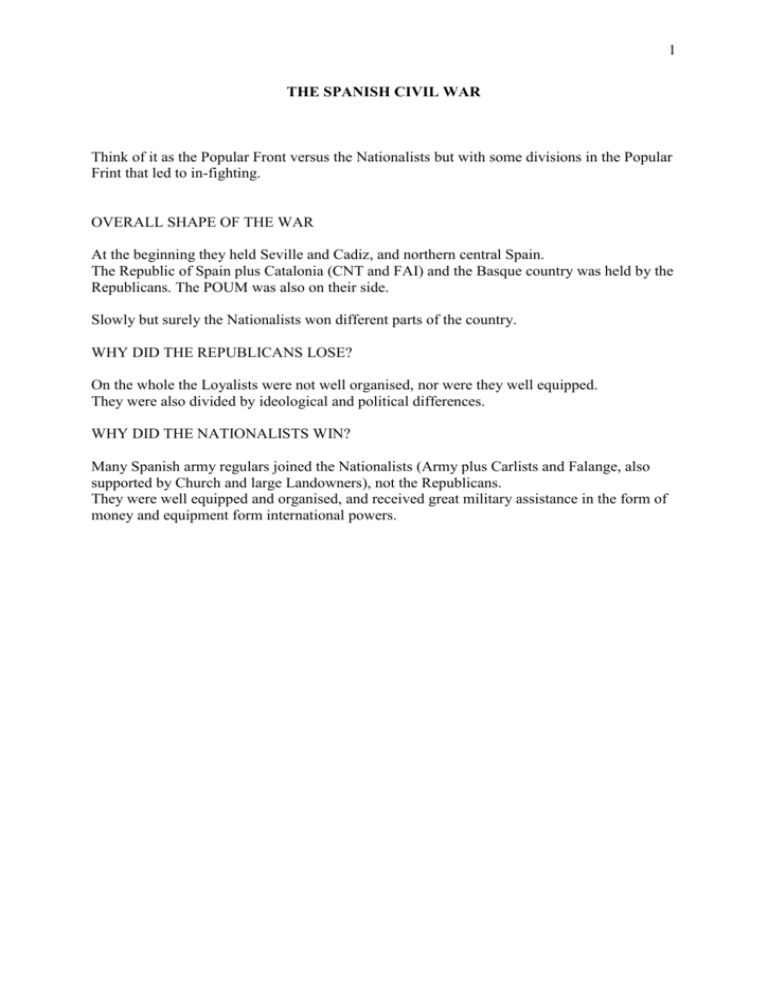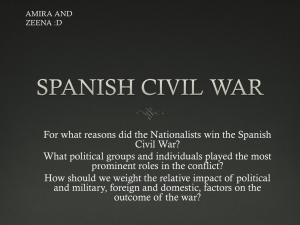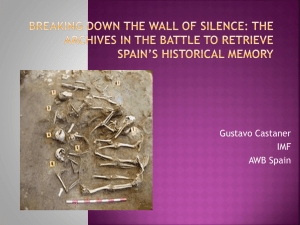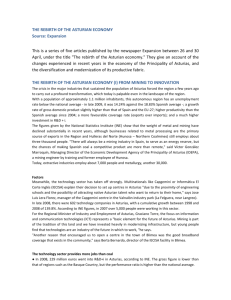SPANISH CIVIL WAR
advertisement

1 THE SPANISH CIVIL WAR Think of it as the Popular Front versus the Nationalists but with some divisions in the Popular Frint that led to in-fighting. OVERALL SHAPE OF THE WAR At the beginning they held Seville and Cadiz, and northern central Spain. The Republic of Spain plus Catalonia (CNT and FAI) and the Basque country was held by the Republicans. The POUM was also on their side. Slowly but surely the Nationalists won different parts of the country. WHY DID THE REPUBLICANS LOSE? On the whole the Loyalists were not well organised, nor were they well equipped. They were also divided by ideological and political differences. WHY DID THE NATIONALISTS WIN? Many Spanish army regulars joined the Nationalists (Army plus Carlists and Falange, also supported by Church and large Landowners), not the Republicans. They were well equipped and organised, and received great military assistance in the form of money and equipment form international powers. 2 FEATURES OF SPANISH SOCIETY Spain was highly divided, in terms of regionalism – Basques, Catalans, Galicians etc… People were more faithful to and loved their locality more than their country Spain There were sharp economic divisions, between highly industrialised parts and backward agricultural parts; between small peasant agriculture and vast estate agriculture. Rich landowners, army and church were the political right. 50,000 owned 50% of the land. Spanish church was very influential, especially in education. These differences and tensions were being exacerbated due to the economic depression of the 1930s. THE POLITICAL GROUPS INVOLVED LEFT CENTRE RIGHT = CNT, FAI, PCE, POUM, PSOE, UGT, PSUC. = PNV, UMRA, PS, UR, IR. = Carlists, CEDA ; Bloque Nacional ; Renovacion Espanola ; UME 3 TRIGGER: - MILITARY REBELLION OF JULY 1936 July 17th 1936: Generals Franco, Goded and Mola organised a rebellion with the Spanish military in Morocco. The British navy and Hitler helped them. Hesitation on the part of the Republican government to act and to arm non-governmental organizations meant, ultimately, they could not crush it. HISTORIOGRAPHY Pio Moa controversially claims that the main cause of the Spanish Civil War was the antideomocratic “red menace” of extreme-left communism. The radicalisation of the left in power under the Popular Front (assassinations of militants and politicians of the democratic left by the "pistoleros" of the CNT and the Young Socialists radicalsied the Conservatives. The coup was a response to the revolutaionry process begun by Largo Caballero hand his partisans in 1934 (similar to Octobre 1917 against Kerensky’s government in Russia. So he blames the PSOE and its Catalan allies of the Esquerra Republicana de Catalunya. Paul Preston see this as the equivalent of the Fascist’s own explanation of the origins of the civil war. POLITICAL IDEOLOGIES – 1936-1939 The rise of various left-wing political ideologies from the beginning of the century. Rise of socialism, anarchism and anti-clericalsim led to outbreaks of violence (Tragic Week of 1909) By the 1930s there was a considerable number, this led to a proliferation of political groups with different aspirations, in part due to the varied nature of Spanish, be it landowning patterns, or the extent of industrialisation Anarcho-syndicalism in Catalonia (Barcelona etc) – it was heavily industrialised. (central government replaced by local worker controlled government) CNT. Anarchism was stronger in the countryside, such as Andalusia – they wanted a revolution in the form of land redistribution, decentralized authority and freedom from taxes. Other variants of Marxism – Stalinists, Trotskyists, Socialists, Trade Unionists. LEFT CENTRE = CNT, FAI, PCE, POUM, PSOE, UGT, PSUC. = PNV, UMRA, PS, UR, IR. 4 RIGHT = Carlists, CEDA ; Bloque Nacional ; Renovacion Espanola ; UME 5 LONG TERM CAUSE – POLITICAL INSTABILITY There had been an unsteady swing between conservative monarchism and republicanism since the middle of the 19th century. The First Spanish Republic had been overthrown in 1874. This is also known as the restoration of the monarchy under Alphonso XII. The Restorationists introduced a spoof ‘democratic’ political party system called El Turno Pacfico by which elections were rigged and the two parties (right and centre) alternated power peacefully between them. However, by 1921, especially after the debacle in Spanish Morocco, Spain had a discredited monarchy supported by a military dictatorship – Primo de Rivera was appointed Prime Minister by the King and for seven years (1923-1930) was a dictator, ending the turno system of alternating parties. Mistreatment of the Moorish population in Spanish Morocco led to an uprising and the loss of this North African possession except for the enclaves of Ceuta and Melilla in 1921. (See Abd el-Krim, Annual). In order to avoid accountability, King Alfonso XXIII decided to support the dictatorship of General Miguel Primo de Rivera, ending the period of constitutional monarchy in Spain. In joint action with France, the Moroccan territory was recovered (1925–1927), but in 1930 bankruptcy and massive unpopularity left the king no option but to force Primo de Rivera to resign. Disgusted with the king's involvement in his dictatorship, the urban population voted for republican parties in the municipal elections of April 1931. The king fled the country without abdicating and a republic was established. By 1931 the institution of the monarchy was discredited. By April 1931 that army had withdrawn its support for the monarchy and King Alphonso slipped into exile. In June 1931 a democratic election voted for a coalition of centre-left parties led by Manuel Azana as Prime Minister. The Second Spanish Republic was declared Second Spanish Republic lasted from April 14th 1931 to April 1st 1939 SHORT TERM POLITICAL INSTABILITY This showed itself in massive changes in democratically elected government within its first few years – 1931, 1933 and 1936 as well as the radicalisation of the extreme left and right and violent reactions against the encumbent government’s policies The first governments of the Republic, were center-left, headed by Niceto AlcaláZamora, and Manuel Azaña In the 1933/34 elections there was a swing to the right and the right-wing CEDA won power - José María Gil Robles led a coalition of center-right and far-right parties. 6 President Niceto Alcalá Zamora refused to ask its leader, José Maria Gil Robles, to form a government, and instead assigned the task to Alejandro Lerroux of the Radical Republican Party. CEDA supported the centrist government led by Lerroux; it later demanded and, on October 1st, 1934, received three ministerial positions. They suspended most of the reforms of the previous Manuel Azaña government, provoking an armed miners' rebellion in Asturias on October 6, and an autonomist rebellion in Catalonia - both rebellions were suppressed (Asturias rebellion by young General Francisco Franco), being followed by mass political arrests and trials. By 1936 there was a call for more elections which in February 1936 resulted in a victory for the left. DISAGREEMENTS/DISATISFACTIONS OVER ECONOMIC AND SOCIAL POLICIES OF THE 1931-1933 REPUBLICAN GOVERNMENT The first center-left 1931 Government, headed by Niceto Alcalá-Zamora, and Manuel Azaña began to introduce a series of laws to reform agriculture, labour, and anti-clerical laws. Some anti-clerical laws aimed at splitting the church from the state; recognising civil marriages and divorces. Some anti-military laws included the forced retirement of many army officers. Women were allowed to vote in general elections for the first time. The Republic devolved substantial autonomy to the Basque Country and to Catalonia. The biggest problem was the economic turmoil and substantial debt it inherited from the Primo de Rivera regime, as well as the fractious, rapidly changing governing coalitions led to serious political unrest. Among other constitutional freedoms, the new constitution was to establish freedom of speech and freedom of association, Separation of Church and State and a right to divorce as well as extending universal suffrage to women. It stripped the Spanish nobility of any juridical status, simplified the Legislative branch to a single chamber called the Congreso de los Diputados, and established legal procedures for the nationalisation of public services such as land, banks and railways. The Republican Constitution also changed the symbols of the country. The Himno de Riego was established as the National Anthem and the Tricolour, with three horizontal red-yellow-purple fields, became the flag of Spain. Under the new Constitution, all of Spain's regions had the right to autonomy. Catalonia (1932) and the Basque Country (1936) exercised this right, with Andalucía, Aragón and Galicia in talks before the breakout of the Civil War. Overall, in spite of a wide range of liberties, the Constitution failed to agree in key areas with the conservative right, which was very rooted in rural areas, and the Roman Catholic Church, which was stripped of schools and public subsidies under the new Constitution CONSEQUENCES OF THESE POLICIES 7 These laws alienated the right, and extreme left, and did little to touch poverty in rural Spain. They started to radicalise political positions August 1932: The Civil Guard under General Sanjurjo rebelled. It was put down and he was imprisoned. Only to be released and later join Franco’s rebellion. In 1933 Jose Antonio Primovera founded the Falange. In 1933, the right-wing CEDA won power This government began suspending all the reforms introduced by the previous government. The 1933/34 government, with its 3 CEDA Ministers suspended most of the reforms of the previous Manuel Azaña government. This provoked an armed miners' rebellion in Asturias on October 6, and an autonomist rebellion in Catalonia - both rebellions were suppressed (Asturias rebellion by young General Francisco Franco), being followed by mass political arrests and trials. These policies further radicalised political positions 1933 Catalonia declared itself autonomous. In October 6th, 1934, as a result of the inclusion of 3 CEDA ministers in the government November 1933 a right wing coalition was elected and immediately reversed Azana’s reforms. In the 1933 elections, the CEDA won the most seats in the Cortes. President Niceto Alcalá Zamora refused to ask its leader, José Maria Gil Robles, to form a government, and instead assigned the task to Alejandro Lerroux of the Radical Republican Party. CEDA supported the centrist government led by Lerroux; it later demanded and, on October 1, 1934, received three ministerial positions. They suspended most of the reforms of the previous Manuel Azaña government, provoking an armed miners' rebellion in Asturias on October 6, and an autonomist rebellion in Catalonia - both rebellions were suppressed (Asturias rebellion by young General Francisco Franco), being followed by mass political arrests and trials. The suspension of the land reforms that had been attempted by the previous government, and the failure of the Asturias miners' uprising, led to a more radical turn by the parties of the left, especially in the PSOE (Socialist Party), where the moderate Indalecio Prieto lost ground to Francisco Largo Caballero, who advocated a socialist revolution. At the same time the involvement of the Centrist government party in the Straperlo scandal deeply weakened it, further polarising political differences between right and left. These differences became evident in the 1936 elections. there was a general strike and an armed rising of workers which reached its greatest intensity in Asturias and Catalonia. 8 Miners in Asturias occupied the capital, Oviedo, killing officials and clergymen and burning theatres and the University. It was forcefully put down by the CEDA government – by sending in the army led by Franco.1 This in turn energized political movements across the spectrum in Spain, including a revived anarchist movement and new reactionary and fascist groups, including the Falange and a revived Carlist movement. In elections on February 16, 1936, CEDA lost power to the left-wing Popular Front. This created more unrest. On January 7, 1936, new elections were called. Despite significant rivalries and disagreements the Socialists, Communists, and the Catalan and Madrid-based left-wing Republicans decided to work together under the name Popular Front. The Popular Front won the election on February 16 with 263 MPs against 156 right-wing MPs, grouped within a coalition of the National Front with CEDA, Carlists and Monarchists. 1936 election: The left wing parties formed the Popular Front to oppose rise of fascist parties. They won, despite their inner divisions. After the Popular Front won the elections in February 1936, president Manuel Azaña proposed that Prieto join the government, but Largo blocked these attempts at collaboration between PSOE and the Republican government. Largo dismissed fears of a military coup, and predicted that, were it to happen, a general strike would defeat it, opening the door to the workers' revolution. On July 12 1936, Lieutenant José Castillo, an important member of the anti-fascist military organization Unión Militar Republicana Antifascista (UMRA), was murdered by Falangist gunmen. In retaliation the following day, July 13, UMRA members shot José Calvo Sotelo, leader of the right-wing opposition and the most prominent Spanish monarchist who, describing the government's actions as Bolshevist and Anarchist, had been exhorting the army to violence, declaring that Spanish soldiers "would be mad not to rise for Spain against anarchy". 1 For a month, a socialist republic was formed in Asturias, with a total Marxist administration. Troops under the command of Francisco Franco were brought from the North African colonies to put down the rebellion and a ferocious oppression followed. As a result, Asturias remained loyal to the democratic republican government during the Spanish Civil War, and was the scene of an extraordinary defence in extreme terrain, the Battle of El Mazuco. With Franco eventually gaining control of all Spain, Asturias—traditionally linked to the Spanish crown—was known merely as the "Province of Oviedo" from 1936 until Franco's death in 1975. The province's name was restored fully after the return of democracy to Spain, in 1977. In 1982, Asturias became an Autonomous Community within the decentralized territorial structure established by the Constitution of 1978. The Asturian regional government holds comprehensive competencies in important areas such as health, education and protection of the environment. Since 1999, the President of the Government of Asturias has been Vicente Álvarez Areces, of the Spanish Socialist Worker's Party 9 The Right blamed the government for Calvo Sotelo's assassination. Although it is sometimes considered the catalyst for the further political polarisation that ensued, the Falange and other right-wing conspirators, including Juan de la Cierva, had already been conspiring to launch a military coup d'état against the government, to be led by senior army officers. ECONOMIC DEPRESSION – financial crisis this involved contributed to forcing Primo de Rivera to resign LANDOWNING ‘Desamortizacion’ of 1931 – extended the amount of land under cultivation. ‘Latifundia’ in southeast quandrant (Extramadura, Awestern Andalucia and La Mancha – some owned thousand of acres whilst many peasant families were landless Tradition of ‘family farm going back to 18TH and reformers such as Jovellanos and Florez Estrada In the north holdings were very small. In old Castile and Aragon they were medium sized. 10 ROLE OF INTERNATIONAL INFLUENCE US and UK claimed non-alignment but secretly feared communism so wanted the Nationalists to win. INTERNATIONAL BRIGADES Popular opinion saw it as democracy against fascism. Volunteers from all over the world formed International Brigades and came to help the Republicans – they were usually organized by the Comintern. GERMANY July 25 1936 Hitler sent 20 transport planes to help bring troops from North Africa to Spanish mainland, and later the Condor Legion (German Luftwaffe) – it was they who bombed Guernica. German help became increasingly important 1937-1938. ITALY November 1936 mutual agreement. Mussolini sent CTV (70,000) plus 700 aircraft and 900 tanks. USSR October 1936 the USSR was helping Republicans – but the Republicans had to pay USSR (Stalin had his own problems) in gold (no credit). On top of that, the organization of international brigades was run by Soviets and this caused inner tensions and conflicts. FRANCE The French Popular Front government was cautious about offering help, mainly because its ally UK did not want to upset Italy or Germany. Leon Blum tried to get everyone to stay out of it – he set up the Non Intervention Committee – but only France and UK followed it and stopped supplying arms to either side. This pushed the Republicans closer to the USSR. US The US were tied by Neutrality Acts – although they did sell Nationalists oil. Non-intervention damaged the Republicans, and had little adverse effect on the Nationalists. 11 THE COURSE OF THE WAR Republicans attacked Falangists and Catholic clergy. Nationalists attacked anarchists, communists and trade unionist members. The poet Frederico Garcia Lorca was executed by nationalists early in the war Republican forces were usually on the defensive. 1936 September-November: Famously they stopped the nationalists first attacks on Bilbao in September 1936 and Madrid in November 1936. The siege of Madrid lasted 3 years and became the rallying cry “No Passaran!” (they shall not pass) – the words of Delores Ibarruri 1937 Franco’s troops receive Italian and German reinforcements April 26th 1937 German Condor legion attacks the Basque region, the town of Guernica. Basque region held out until June 1937 when Bilbao fell. Tensions between left-wing parties constantly undermined the Republicans May 1937 in Barcelona, Communists started fighting Anarchists. The May 3–8, 1937 revolt in Barcelona by the oppositional communist Workers' Party of Marxist Unification (POUM) and the anarchist CNT following an attempt to seize the telephone exchange by the PCE at the behest of Prieto led to a governmental crisis, forcing Caballero's resignation on 17 May or 18 May leading to the Popular Front government of doctor Juan Negrín, also a member of the PSOE. October 1937 Republicans only had a large southern territory and some territory around Barcelona. 1938 July to November – the Ebro offensive: Republicans tried to join these tow areas 1939 All Republican strongholds had fallen except Madrid and Valencia February – UK and France recognised Franco as legitimate government of Spain April 2nd Republicans surrendered. 7 famous battles: January 1937 - Jarama 12 Nov 1937-Mar 1939 - Madrid July 1937 - Brunete June 1937 - Aragon (Republicans trying to relieve pressure on Bilbao) February 1937 – Malaga – many Republicans executed July-Nov 1938 – Ebro (Republcians trying to slow approach to Valencia; Republcians destroyed. A major turning point Guadalajara 13 WHY REPUBLICANS LOST AND WHY NATIONALISTS WON No effective central command and control Infighting Lack of arms and manpower Offensives costly Nationalists got impressive foreign aid – German Condor legion, Moroccan regular soldiers provided experienced knowledge. 14 CONSEQUENCES OF THE WAR Immediate social consequences was, as with any war, death of human beings. Between July 1936-1939 half a million people died, mostly civilians What primitive infrastructure they had was destroyed. Prelude to military tactics in WW2 Prelude to international left fighting expansionary fascism. Oppression versus freedom Workers and unions versus landed/industrial interests Fascists now on border of France and had access to the sea (the Atlanatic) Luckily Franco was reluctant to wholeheartedly support Germany in WW2. CHARACTERS AND GROUPS Francisco Laego Caballero(Leader of PSOE and UGT) PM September 1936 – May 1937 Fled to France. Died in Dachau in 1946. Juan Negrin (1892-1956) He followed Caballero as PM Workers' Party of Marxist Unification (POUM) The anarchist trade union Confederación Nacional del Trabajo (CNT), Spanish Socialist Workers' Party (PSOE) Communist Party of Spain (PCE) Spanish Confederation of the Autonomous Right (CEDA)









